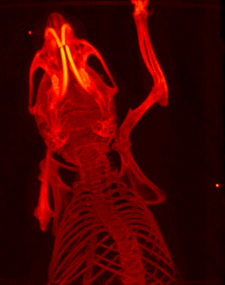 | ||
In scientific visualization, a maximum intensity projection (MIP) is a volume rendering method for 3D data that projects in the visualization plane the voxels with maximum intensity that fall in the way of parallel rays traced from the viewpoint to the plane of projection. This implies that two MIP renderings from opposite viewpoints are symmetrical images if they are rendered using orthographic projection.
This technique is computationally fast, but the 2D results do not provide a good sense of depth of the original data. To improve the sense of 3D, animations are usually rendered of several MIP frames in which the viewpoint is slightly changed from one to the other, thus creating the illusion of rotation. This helps the viewer's perception to find the relative 3D positions of the object components. However, since the projection is orthographic the viewer cannot distinguish between left or right, front or back and even if the object is rotating clockwise or anti-clockwise.
MIP is used for the detection of lung nodules in lung cancer screening programs which utilise computed tomography scans. MIP enhances the 3D nature of these nodules, making them stand out from pulmonary bronchi and vasculature.
MIP imaging was invented for use in Nuclear Medicine by Jerold Wallis, MD, in 1988, and subsequently published in IEEE Transactions in Medical Imaging. In the setting of Nuclear Medicine, it was originally called MAP (Maximum Activity Projection). Additional information can be found in other articles by the same author,.
Use of depth weighting during production of rotating cines of MIP images can avoid the problem of difficulty of distinguishing right from left, and clockwise vs anti-clockwise rotation. MIP imaging is used routinely by physicians in interpreting Positron Emission Tomography (PET) or Magnetic Resonance Angiography studies.
